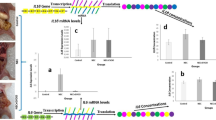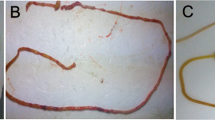Abstract
Objective
To determine the preventative effect of caffeic acid phenethyl ester (CAPE) in necrotizing enterocolitis (NEC) in an experimental rat model of NEC.
Materials and methods
Thirty newborn Sprague–Dawley rats were randomly divided into three groups; as NEC, NEC + CAPE and control. NEC was induced by enteral formula feeding, subjected to hypoxia–hyperoxia and cold stress. Pups in the NEC + CAPE group were treated with CAPE at a dose of 30 mg/kg daily by intraperitoneal route from the first day to the end of the study. All pups were executed on the fourth day. Proximal colon and ileum were allocated for histopathologic and biochemical evaluation, including xanthine oxidase (XO), total antioxidant status (TAS), total oxidant status (TOS), malonaldehyde (MDA) and myeloperoxidase (MPO) activities.
Results
The pups in the NEC + CAPE group had better histopathologic and apoptosis evaluations (TUNEL and caspase-9) and the severity of bowel damage was significantly lower in the NEC + CAPE group compared to the NEC group (P < 0.01). The clinical sickness scores and body weight in the NEC + CAPE group was significantly better compared to the NEC group (P < 0.05). Tissue MDA, MPO, XO levels and TOS were remarkably reduced in the NEC + CAPE group, however, TAS was significantly increased in the NEC + CAPE group (P < 0.05).
Conclusion
Treatment with CAPE reduces the intestinal damage in NEC.






Similar content being viewed by others
References
Lin PW, Nasr TR, Stoll BJ (2008) Necrotizing enterocolitis: recent scientific advances in pathophysiology and prevention. Semin Perinatol 32:70–82
Lin PW, Stoll BJ (2006) Necrotizing enterocolitis. Lancet 368:1271–1283
Thompson AM, Bizzarro MJ (2008) Necrotizing enterocolitis in newborns: pathogenesis, prevention and management. Drugs 68:1227–1238
Hsueh W, Caplan MS, Qu XW, Tan XD, De Plaen IG, Gonzalez-Crussi F (2003) Neonatal necrotizing enterocolitis: clinical considerations and pathogenetic concepts. Pediatr Dev Pathol 6:6–23
Patole S (2007) Preventin and treatment of necrotizing enterocolitis in preterm infants. Early Hum Dev 83:635–642
Ek RO, Serter M, Ergin K, Yildiz Y, Cecen S, Kavak T, Yenisey C (2008) The effects of caffeic acid phenethyl ester (CAPE) on TNBS-induced colitis in ovariectomized rats. Dig Dis Sci 53:1609–1617
Marquez N, Sancho R, Macho A, Calzado MA, Fiebich BL, Munoz E (2004) Caffeic acid phenethyl ester inhibits T-cell activation by targeting both nuclear factor of activated T-cells and NF-kappaB transcription factors. J Pharmacol Exp Ther 308:993–1001
Cicala C, Morello S, Iorio C, Capasso R, Borrelli F, Mascolo N (2003) Vascular effects of caffeic acid phenethyl ester (CAPE) on isolated rat thoracic aorta. Life Sci 73:73–80
Yildiz Y, Serter M, Ek RO, Ergin K, Cecen S, Demir EM, Yenisey C (2009) Protective effects of caffeic acid phenethyl ester on intestinal ischemia-reperfusion injury. Dig Dis Sci 54:738–744
Yilmaz HR, Uz E, Yucel N, Altuntas I, Ozcelik N (2004) Protective effect of caffeic acid phenethyl ester (CAPE) on lipid peroxidation and antioxidant enzymes in diabetic rat liver. J Biochem Mol Toxicol 18:234–238
Zani A, Cordischi L, Cananzi M, De Coppi P, Smith VV, Eaton S, Pierro A (2008) Assessment of a neonatal rat model of necrotizing enterocolitis. Eur J Pediatr Surg 18:423–426
Caplan MS, Hedlund E, Adler L, Hsueh W (1994) Role of asphyxia and feeding in a neonatal rat model of necrotizing enterocolitis. Pediatr Pathol 14:1017–1028
Jilling T, Lu J, Jackson M, Caplan MS (2004) Intestinal epithelial apoptosis initiates gross bowel necrosis in an experimental rat model of neonatal necrotizing enterocolitis. Pediatr Res 55:622–629
Devrim E, Çetin M, Namuslu M, Ergüder IB, Çetin R, Durak I (2009) Oxidant stress due to non ionic low osmolar contrast medium in rat kidney. Indian J Med Res 130:433–436
Lowry OH, Rosebrough NJ, Farr AL, Randall RJ (1951) Protein measurement with the folin phenol reagent. J Biol Chem 193:265–275
Prajda N, Weber G (1975) Malignant transformation-linked imbalance: decreased xanthine oxidase activity in hepatomas. FEBS Lett 59:245–249
Vaghasiya JD, Sheth NR, Bhalodia YS, Jivani NP (2010) Exaggerated liver injury induced by renal ischemia reperfusion in diabetes: effect of exenatide. Saudi J Gastroenterol 16:174–180
Erel O (2005) A new automated colorimetric method for measuring total oxidant status. Clin Biochem 38:1103–1111
Draper HH, Hadley M (1990) Malondialdehyde determination as index of lipid peroxidation. Methods Enzymol 186:421–431
Gulec M, Gurel A, Armutcu F (2006) Vitamin E protects against oxidative damage caused by formaldehyde in the liver and plasma of rats. Mol Cell Biochem 290:61–67
Tihan DN, Erbil Y, Seven R et al (2011) The effect of glutamine on oxidative damage in an experimental abdominal compartment syndrome model in rats. Ulus Travma Acil Cerrahi Derg 17:1–8
Clark JA, Lane RH, Maclennan NK et al (2005) Epidermal growth factor reduces intestinal apoptosis in an experimental model of necrotizing enterocolitis. Am J Physiol Gastrointest Liver Physiol 288:755–762
Claud EC (2009) Neonatal necrotizing enterocolitis—inflammation and ıntestinal ımmaturity. Antiinflamm Antiallergy Agents Med Chem 8:248–259
Nankervis CA, Giannone PJ, Reber KM (2008) The neonatal intestinal vasculature: contributing factors to necrotizing enterocolitis. Semin Perinatol 32:83–91
Claud EC, Walker WA (2001) Hypothesis: inappropriate colonization of the premature intestine can cause neonatal necrotizing enterocolitis. FASEB J 15:1398–1403
Kettle AJ, Winterbourn CC (1997) Myeloperoxidase: a key regulator of neutrophil oxidant production. Redox Rep 3:3–15
Mallick IH, Yang W, Winslet MC, Seifalian AM (2004) Ischemia–reperfusion injury of the intestine and protective strategies against injury. Dig Dis Sci 49:1359–1377
Ozyurt H, Irmak MK, Akyol O, Söğüt S (2001) Caffeic acid phenethyl ester changes the indices of oxidative stress in serum of rats with renal ischaemia–reperfusion injury. Cell Biochem Funct 19:259–263
Koltuksuz U, Ozen S, Uz E, Aydinç M, Karaman A, Gültek A, Akyol O, Gürsoy MH, Aydin E (1999) Caffeic acid phenethyl ester prevents intestinal reperfusion injury in rats. J Pediatr Surg 34:1458–1462
Jennifer WL, Davis JM (2011) Future applications of antioxidants in premature infants. Curr Opin Pediatr 22:161–166
Romero FJ, Bosch-Morell F, Romero MJ, Jareño EJ, Romero B, Marín N, Romá J (1998) Lipid peroxidation products and antioxidants in human disease. Environ Health Perspect 106:1229–1234
Ma Z, Wei X, Fontanilla C, Noelker C, Dodel R, Hampel H, Du Y (2006) Caffeic acid phenethyl ester blocks free radical generation and 6-hydroxydopamine-induced neurotoxicity. Life Sci 79:1307–1311
Sharma R, Tepas JJ 3rd (2010) Microecology, intestinal epithelial barrier and necrotizing enterocolitis. Pediatr Surg Int 26:11–21
Claud EC, Walker WA (2008) Bacterial colonization, probiotics, and necrotizing enterocolitis. J Clin Gastroenterol 42:46–52
Martin CR, Walker WA (2006) Intestinal immune defences and the inflammatory response in necrotising enterocolitis. Semin Fetal Neonatal Med 11:369–377
Ara C, Esrefoglu M, Polat A, Isik B, Aladag M, Gul M, Ay S, Tekerleklioglu MS, Yilmaz S (2006) The effect of caffeic acid phenethyl ester on bacterial translocation and intestinal damage in cholestatic rats. Dig Dis Sci 51:1754–1760
Saavedra-Lopes M, Ramalho FS, Ramalho LN, Andrade-Silva A, Martinelli AL, Jordão AA Jr, Castro-e-Silva O, Zucoloto S (2008) The protective effect of CAPE on hepatic ischemia/reperfusion injury in rats. J Surg Res 150:271–277
Natarajan K, Singh S, Burke TR Jr, Grunberger D, Aggarwal BB (1996) Caffeic acid phenethyl ester is a potent and specific inhibitor of activation of nuclear transcription factor NF-kappa B. Proc Natl Acad Sci USA 93:9090–9095
Montpied P, de Bock F, Rondouin G, Niel G, Briant L, Courseau AS, Lerner-Natoli M, Bockaert J (2003) Caffeic acid phenethyl ester (CAPE) prevents inflammatory stress in organotypic hippocampal slice cultures. Brain Res Mol Brain Res 115:111–120
Fitzpatrick LR, Wang J, Le T (2001) Caffeic acid phenethyl ester, an inhibitor of nuclear factor-kappaB, attenuates bacterial peptidoglycan polysaccharide-induced colitis in rats. J Pharmacol Exp Ther 299:915–920
Hunter CJ, Upperman JS, Ford HR, Camerini V (2008) Understanding the susceptibility of the premature infant to necrotizing enterocolitis (NEC). Pediatr Res 63:117–123
Amodio R, De Ruvo C, Sacchetti A, Di Santo A, Martelli N, Di Matteo V, Lorenzet R, Poggi A, Rotilio D, Cacchio M, Esposito E (2003) Caffeic acid phenethyl ester blocks apoptosis induced by low potassium in cerebellar granule cells. Int J Dev Neurosci 21:379–389
Yang J, Marriner GA, Wang X, Bowman PD, Kerwin SM, Stavchansky S (2010) Synthesis of a series of caffeic acid phenethyl amide (CAPA) fluorinated derivatives: comparison of cytoprotective effects to caffeic acid phenethyl ester (CAPE). Bioorg Med Chem 18:5032–5038
Ito N, Hirose M, Takahashi S (1993) Cell proliferation and forestomach carcinogenesis. Environ Health Perspect 101:107–110
Kagawa M, Hakoi K, Yamamoto A, Futakuchi M, Hirose M (1993) Comparison of reversibility of rat forestomach lesions induced by genotoxic and non-genotoxic carcinogens. Jpn J Cancer Res 84:1120–1129
Hirose M, Kawabe M, Shibata M, Takahashi S, Okazaki S, Ito N (1992) Influence of caffeic acid and other o-dihydroxybenzene derivatives on N-methyl-N’ -nitro-N-nitrosoguanidineinitiated rat forestomach carcinogenesis. Carcinogenesis 13:1825–1828
Acknowledgments
This study was supported by a Grant of Fatih University Scientific Research Committee.
Author information
Authors and Affiliations
Corresponding author
Rights and permissions
About this article
Cite this article
Tayman, C., Tonbul, A., Kosus, A. et al. Protective effects of caffeic acid phenethyl ester (CAPE) on intestinal damage in necrotizing enterocolitis. Pediatr Surg Int 27, 1179–1189 (2011). https://doi.org/10.1007/s00383-011-2942-0
Accepted:
Published:
Issue Date:
DOI: https://doi.org/10.1007/s00383-011-2942-0




